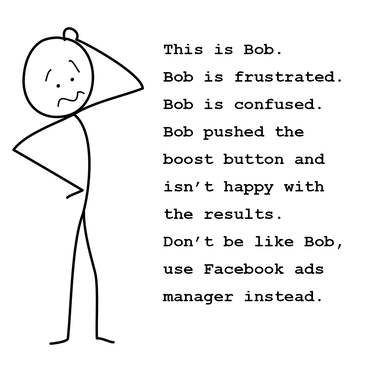Jamie Jean Schneider DommDigital Strategist for the North American Division. In other words, don’t be like Bob and push that button, because you could be limiting your options, wasting your ad dollars, and curtailing your desired results.It’s tempting. It’s easy. You can push that blue boost button right from your phone, and you imagine that you’re expanding the reach of your post beyond your wildest dreams. Well, you’re not really. Let me explain. If you’re new to social advertising, boosting a Facebook post is appealing because it’s easy to access and simple to set up. But if you’re on a limited budget and looking to maximize your results within a target audience, boosted posts are not the way to go. This blog post will discuss why you may end up wasting your precious ad dollars when you boost, the enormous value Facebook Ads offers your ministry through other, more effective campaign objectives and targeting, and the rare situations in which it’s okay to push that boost button. The Facebook Ads platform is king when it comes to social advertising, and it can be your secret weapon for delivering your message effectively to your target audience. Whether you’re a tiny ministry or a for-profit Fortune 500 company, Facebook’s advertising platform delivers unrivaled value (as of May 2019) in terms of precise targeting, customizable advertising, and affordable buys for any budget. It offers more psycho-demographic information about your audience than any other advertising platform, including but not limited to: interests, behaviors, household income, age, gender, religious or political beliefs, relationship status, occupation, age of children in the home, etc. The possibilities are almost endless. However, the boosting interface (remember that blue boost button?) strips these targeting options down to a minimum and limits your ability to combine and exclude targeting filters. While boosted posts make advertising easy for the newbie, most of the boost advertising options are purposefully limited. You will not be able to leverage the full power of Facebook Ads targeting with optimized results. Facebook Ads manager offers more than 17 marketing objectives that are not available in the boosting interface. Choosing the right objective for a highly targeted audience produces a winning combination that will stretch your ad dollars while maximizing results. Conversely, boosted posts frequently cast the net too wide for small budgets to create impact among a desired demographic. To summarize, here are the three reasons to avoided pushing the boost button:
When is it a good idea to click the boost button?
To achieve good results with your social advertising campaigns, you must embrace good advertising practices. That means doing social advertising the right way: through Facebook Business or Ads manager. It is a very user-friendly tool, and the results will make the learning curve worth it. As Christians, this is also embraces good stewardship. We should take the time to learn how to use the tools at our disposal in a way that optimizes the funds we have been blessed with to do God’s work. To view all of Facebook’s targeting options, check out this useful infographic from Wordstream.
Dustin Comm
5/2/2019 01:37:52 pm
Yes! It's not even close. If you're not familiar with Ads Manager, it may take a bit of exploring to see what it can do, but it is worth it. Great piece Jamie.
Jamie Domm
5/6/2019 12:40:12 pm
Thanks Dustin
Jamie Domm
5/13/2019 10:58:42 am
Denise, you'll have to work with the formatting on your computer in your printer settings for that. Hope that helps!
Sarah
10/28/2019 05:46:17 pm
Hello I watched one of your youtube videos about why you shouldnt press the boost post button. I own a lipgloss company and I was wondering that if I made a detailed ad from the ads manager if it would work and i wouldnt waste my money and if it could increase my sales. Hope to hear from you. Comments are closed.
|
Archives
August 2020
Categories
All
|
||||||
- Home
- BLOG
-
RESOURCES
-
RESOURCE MENU
>
- ADVENTIST IDENTITY GUIDELINES
- BIG DATA RESOURCES
- BRANDING, IMAGE & DESIGN RESOURCES
- CHURCH/MINISTRY SPECIFIC RESOURCES
- COPYRIGHT & TRADEMARK BASICS
- COURSES
- EMAIL RESOURCES
- GUIDANCE FOR HIRING SOCIAL MEDIA POSITIONS
- PODCASTS
- REPORTS & CASE STUDIES
- SOCIAL MEDIA RESOURCES
- (SOCIAL) VIDEO RESOURCES >
- TEXTING 4 CHURCHES
- TRACKING & ANALTYICS
- WATCH VIDEOS & TUTORIALS
- WEBSITE TIPS
- SOCIAL MEDIA GUIDELINES
-
RESOURCE MENU
>
- SEO
- Digital Discipleship & Evangelism
- COVID-19 RESOURCES
- eNEWSLETTER



 RSS Feed
RSS Feed